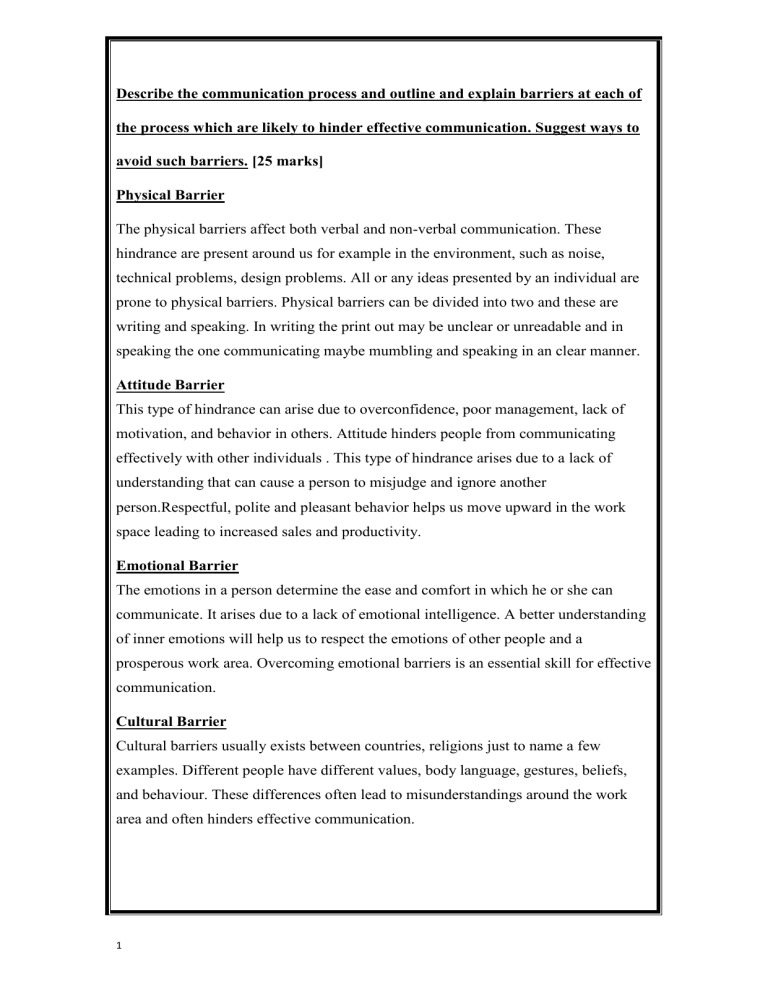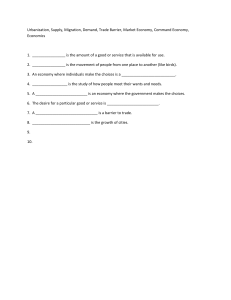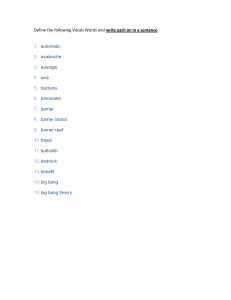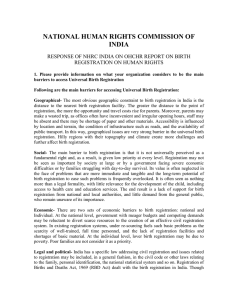
Describe the communication process and outline and explain barriers at each of the process which are likely to hinder effective communication. Suggest ways to avoid such barriers. [25 marks] Physical Barrier The physical barriers affect both verbal and non-verbal communication. These hindrance are present around us for example in the environment, such as noise, technical problems, design problems. All or any ideas presented by an individual are prone to physical barriers. Physical barriers can be divided into two and these are writing and speaking. In writing the print out may be unclear or unreadable and in speaking the one communicating maybe mumbling and speaking in an clear manner. Attitude Barrier This type of hindrance can arise due to overconfidence, poor management, lack of motivation, and behavior in others. Attitude hinders people from communicating effectively with other individuals . This type of hindrance arises due to a lack of understanding that can cause a person to misjudge and ignore another person.Respectful, polite and pleasant behavior helps us move upward in the work space leading to increased sales and productivity. Emotional Barrier The emotions in a person determine the ease and comfort in which he or she can communicate. It arises due to a lack of emotional intelligence. A better understanding of inner emotions will help us to respect the emotions of other people and a prosperous work area. Overcoming emotional barriers is an essential skill for effective communication. Cultural Barrier Cultural barriers usually exists between countries, religions just to name a few examples. Different people have different values, body language, gestures, beliefs, and behaviour. These differences often lead to misunderstandings around the work area and often hinders effective communication. 1 Language Barrier Language barriers are also known as linguistic barriers. A small difference in language can lead to misunderstanding between two or more people who are trying to communicate. It is recommended to use simple language and words while communicating so as to get the point across more easily and avoid misunderstanding one another. Those having a conversation can choose to use one language to communicate so as to avoid misunderstanding one another for example using English instead of using jargon, unfamiliar expressions and abbreviations. Gender Barrier and Differences Gender barriers signify how men and women behave; such barriers include different choices, styles of decision-making, etc. Women prefer to discuss the problems verbally. Overcoming gender barriers are essential to maintain equality in the work space. Gender barriers occur when one for example a male thinks that women are inferior and not worth being listened to. This in turn hinders communication.Women and men are different therefor their needs and wants are different. It is through those different wants and needs that barriers occur in putting their opinions out there for others to hear. So this leads to the person whether him/her to keep quiet so as to avoid criticism and being ridiculed. Lack of focus and eye contact Lack of focus and eye contact is another hindrance to effective communication . Lack of focus and eye contact may lead to the listeners or the audience to lose interest in the message being delivered hence that is why it is a hindrance to effective communication. People tend to trust people who maintain eye contact and stay focused. Lack of focus can be due to various reasons such as improper sleep, overworking hours or alcohol. Fear of mistakes Mistakes are a part of the communication process. The fear of mistakes will make one not take the opportunity or leap to communicate with other individuals hence that is why the fear of mistakes is a hindrance to effective communication. Practice is the best key to reduce mistakes. One can practice exercises to improve his or her communication skills. One must always try to learn from his or her mistakes. 2 Psychological Barrier The psychological state of a person can be a barrier in communication, such as opinion, consciousness, emotions, attitude, and behaviour. It distracts the user form paying attention while communicating for example a person will low confidence may not respond inappropriately while talking to his or her superior. Perceptual Barrier Perceptual barriers are the barriers that prevent a person from correct predictions about others, such as expectations. It depends on how that particular individual analyzes the things around them to recognize any information. The best way to overcome such barriers is to find a positive solution in everything. Socio-religious barriers In the society that we live in a transgender may face many difficulties and barriers while communicating because of the religious views of people. Feedback Issue Feedback ensures that the receiver has correctly interpreted the message from the speaker or sender. It is also an hindrance of communication because the sender or speaker does not know if the message got received correctly. Organizational structure barrier Organizational structure barrier occurs when there is no transparency among the employees and employers. This particular barrier arises because of misinformation. This type of barrier can have a domino effect in an organization and cause work productivity and morale to be low. Technological barrier Technology is developing fast and as a result it becomes difficult to keep with it. Hence that is why technology becomes a hinder because of the fast advancements and developments. The cost of technology is very high hence that is why some organizations will not be able to afford it. Hence this becomes a hindrance. 3 Systematic barriers This hindrance may exist in structures and organisations where there is inappropriate information systems and communication channels. In such situations people may be unclear of their roles in the communication process. Interpersonal barriers This type of hindrance occurs when two or more individuals hate or do not like one another in an organisation and this in turn creates a situation where progress cannot occur within the organization because of the dislikes among the co-workers. Non verbal communication Non verbal communication is another hinder of communication. This type of barrier is used when two or more people are communicating with each other in a form other than written or spoken words such as gestures, facial expressions or body language. It is a type of barrier when the other person in the conversation analyses too much into it for example when Sam and John are non verbally communicating with each other and Sam is a sweater and starts sweating profusely. John would think that Sam is lying to him when that is not the case. Selective perception Selective perception is another hinder of communication. This type of barrier refers to filtering what one sees and hears to suit his or her needs or background. This occurs when the one receiving the information is bombarded with too much of it and decides to ignore what he deems un useful to him/her. Semantics Semantics is another hinder of communication. This type of barrier refers to the studying the meaning of words. The two or more individuals communicating may not understand each other because the relationship between the words they are using and their meaning may mean a totally different thing altogether resulting in the message being distorted. 4 Filtering It is a type of barrier to effective communication for example a manager who keeps his/her division’s poor sales figure from his or her boss the vice president fearing the bad news will make him angry. So in turn filtering prevents members of the organization from getting the complete picture of the way things are. Emotional Barriers and Taboos Some individuals have difficulty in expressing their emotions and therefor cannot put their points or views across. Some topics may be considered to be taboo or completely off-limits and these include sex,racism,religion and politics just to name a few. There are different ways to avoid such barriers and these are; Suitable time We should always check that the current time is suitable for the communication or not. Sometimes talking to a person who is sad or uninterested will not be two-way communication or wheeled any good results. The other person might not respond appropriately or even deem the information as useless. Be aware of tone, language, and pitch The voice should be audible for the listener. It should not harm the feelings of other users. Try to make the content attractive The content for effective communication should be clear and precise. It should not contain the use of excessive technical words, difficult words, brief paragraphs, explicit words etc. The content should be attractive and pleasant. One should also check for the grammars, spelling, and errors in the content. The content can be verbal and written. Look for feedback 5 Communication is a two-way process. One should ensure that the receiver has properly understood the message. In face-to-face communication, facial expressions can easily depict that the receiver has correctly interpreted the message or not. But in other types of communication, we should always try to seek for the feedback while not fearing whether it will be good or bad. Focus on listening skills Listening skills are essential both for the sender and listener. One should always try to communicate with a positive attitude, clarity and attention to detail. Good listening skills also help listeners to extract maximum information from the content or message being portrayed or delivered. Work on the body language Sitting and standing positions depict the positive attitude and interest of a person in communication. So one should sit and stand straight without any unnecessary hand movements. One should not try to slump the shoulders in between the communication for it shows interest . Body language, postures, and facial expressions are an essential part of the communication process. One should know how to control his or her body language. Maintain eye contact Proper eye contact depicts the interest and attention of a person towards others. It is an essential skill for effective communication. Practice verbal communication skills If one is not confident about speaking in public,one can practice beforehand. One can take speech classes to improve his or her verbal communication skills. Do not focus on distractions Communication becomes better with less or no distractions. One should not focus on the people passing nearby, opening and closing the door, other people talking, mobile phones, etc. Such distractions can affect ones attention and presence from the conversation. 6 Identify and remove the noise source Noise is a significant barrier in the communication process. We need to overcome the sources to avoid any interference. It is essential to identify the factors that cause interference and try to remove such sources of noise. Do not work under pressure Immense work pressure can adversely affect our work performance. One should try to maintain his or her work from the beginning so that he or she can effectively manage our communication with it. It will help one to easily manage his or her work and communication at the end without any pressure. Focus on weakness Effective communication means managing every aspect of communication, either formal or informal. One should regularly work on his or her weaknesses. One can also ask for suggestions to know which aspect of communication will be better. 7 REFERENCE: STRATEGIC BUSINESS COMMUNICATION VOL 1 Business Communication An Introduction English for Business Communication Teacher's book 8




